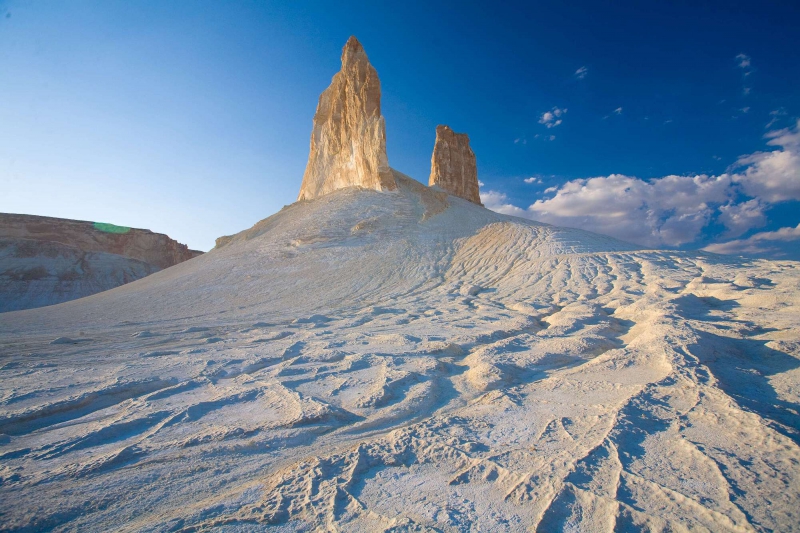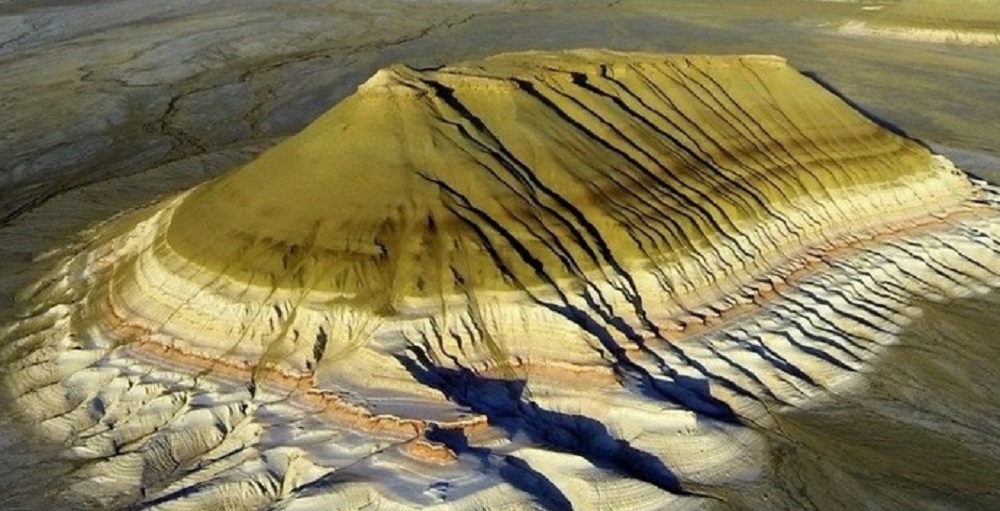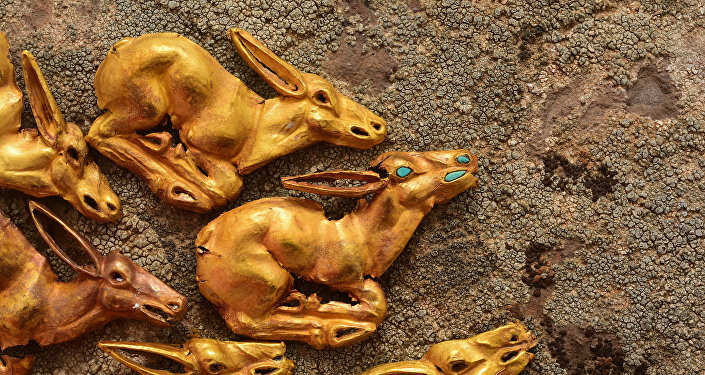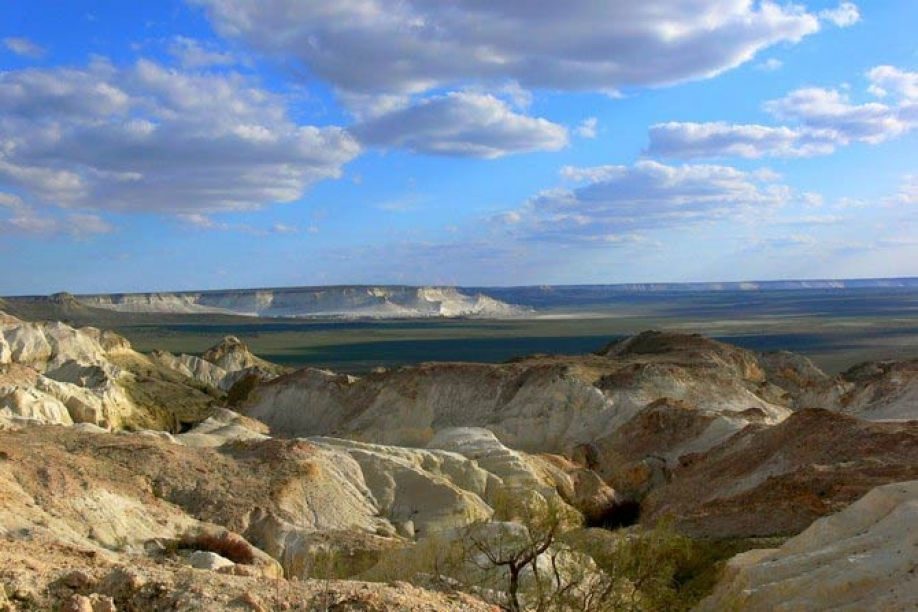
The land of Mangystau is fascinating and unusual. Time has stopped here. Primordial natural landscapes of the Mangystau deserts formed a special thinking of the local inhabitants of antiquity, who, as the greatest memory of themselves, left numerous and unique objects of historical and cultural heritage.
Since ancient times, on the peninsula during the construction of structures widely used easily extracted and available in processing natural stone - limestone-shell rock. This, apparently, easily destroyed material, can for a long time retain the shape and construction of it erected. Having been built two or three thousand years ago, structures from other materials have long since disappeared without trace or changed their appearance beyond recognition. The buildings of Mangystau, even in ruined form, carry a lot of information about the way of life, culture, beliefs and architecture of the ancient population. Geographical isolation of the Mangyshlak peninsula contributed to the long-term preservation of the oldest production skills, systems of economic activity and primitive religions. For this reason, many monuments of antiquity simply do not have analogues in the archaeological environment.
The archaeological and historical studies of Mangystau region have not been expanded accordingly. However, the data available to date allow us to draw a general picture of the formation and development of peoples and types of management for this area in prehistoric and historical times.

A new stage in carrying out archaeological research work in the region is associated with the period of functioning of the state program "Cultural Heritage" with funding received from the republican budget. Mangystau region became the only region in Kazakhstan that undertook to independently support this program.
After 2010, for a number of reasons, archaeological work in the region was suspended. Social problems and the annual change of the leadership of the region did not have the best impact on the development of culture. A large number of projects to preserve the historical and cultural heritage of Mangystau have been frozen, which immediately affected the protection of historical, archeological and architectural monuments. The economic growth of our region leads to intensive development of the territories, unfortunately, without agreement with the local body for the protection and use of monuments.
Let's consider some negative experience of the region...
Employees of the Mangystau State Historical and Cultural Reserve have prevented vandal destruction of unique megalithic structures in the area of the Shytsha Tupkaragan; the stones of the monument were used for construction purposes. With the uncoordinated expansion of the village of Sain, two settlements of the end of the Stone Age were lost. In the area near the necropolis of Barys Mangystau district, the only known in the area tomb of the early Bronze Age was demolished to the base with the expansion of the industrial site. In the backdrop, research was carried out on the construction of the Zhanaozen-Turkmenistan railway line. Despite the definition of the boundaries of the discovered settlements of Korgantas and Ketikkala on the territory of Fort-Shevchenko, there are continued prizes for industrial development of land plots on the territory of the monuments. These are just a few significant examples of incompetence of responsible persons and indifference. It is simply inappropriate to write about legal illiteracy here.
We all live in a state of law. We do not undertake to raise the reasons for this attitude to our memory and history. we deliberately point out to our memory and history. There is no only Kazakh archeology, and not such an ancient one in the historically foreseeable past. But the history of the Kazakh people is genetically related to the glorious past. There is no history without the people, as there are no people without history. The past is international; it has no borders, no nationality. The past belongs to all mankind. Therefore, every state assigns care for its preservation by various legislative acts to itself.
History is always an important political argument that determines the consistency and capacity of a state. Therefore, the preservation of historical heritage is enshrined in state laws. It is no secret that the laws begin to work or not work when it becomes someone profitable. At one time, a scientist with a degree of resentment tell that archeologists are like beggars, with an outstretched hand asking officials to observe the state law on the protection of monuments, although the same officials are required by the same law to observe its execution.

Although Kazakhstan is about to celebrate its 27 years of independence, there are still plenty of problems that have to be resolved. Perhaps, on the general information background these problems are not so bulging, but for our country, far from being poor and far from the low standard of living of the region, they are archon-bearing. These words are not a reproach to the authorities. These words are addressed to people whose responsibilities are to fulfill every letter of the law, even if it is the Law of the Republic of Kazakhstan "On the protection and use of historical and cultural heritage". It is a pity that we remember our past and our roots on significant dates, programs of our president and sensations in the media, which are at variance with the interests of the leadership.
Let's try to reveal how important it is to preserve all objects of historical and cultural heritage, not only for the prestige of our region and the Republic of Kazakhstan, but for understanding and preserving the history of the Eurasian community of nations. The first lines of my narrative may seem very scientific and reportable-dry. The article is based on an article that was written for the 20th anniversary of the Independence of the Republic of Kazakhstan on the achievements of archaeological science in the Mangystau region. I will not cheer if I say that in these results there is a considerable part of my more than 30-year participation in the study of the Mangystau history. In subsequent articles I will try to open my vision of history, archeology, sacred and cult architecture and paleoethnography of the Mangystau region.
Excursion to the history
Archaeological evidence of the initial population of Aral-Caspian people is very scarce and contradictory. The era of the Paleolithic - the ancient Stone Age - is the most important stage in the history of all mankind. There is an opinion that the first human populations, using stone tools, appeared on Mangyshlak more than two million years ago. On the coast of the Gulf of Sartas, replete with exits of flint nodules, the artifacts of the Paleolithic appearance are fixed. But the study of the ancient stone age of Mangystau is a matter of the future.
The main pages of the history of the Mesolithic population of the Mangyshlak Peninsula and the Ustyurt Plateau (Mesolithic - Middle Stone Age) have not yet been studied. The Mangyshlak Mesolithic monuments (e.g. Kyzylsu station) and the closely related industries of Northwestern and Southwestern Ustyurt are vividly characterized by developed laminated stone cleavage technology, end scrapers, nucleated incisors, bifacial tools and sets of geometric microliths. The more than 60 asymmetric trapeziums found in the Kyzylsu parking lot now constitute the most numerous collection of this type of products in Eurasia. The preliminary dating of the parking lot is 10-8 thousand BC.
During the 7th millennium BC., Mangyshlak was penetrated by a large inocultural group of tribes, a direct analogue of the Kukrek archaeological culture, localized in the territory of Southern Ukraine and Crimea. This migration probably had a transitory character from the south to the north. The Kukrek population brought with it a microlithoid plate technology that did not find continuity in the subsequent era. Traces of the presence of the Kukrek population are found on the Buzachi Peninsula, in the Karagiyi Depression, in the sands of Tyuesu, Karynzharyk and Sam.
New Stone Age
The local Neolithic (new Stone Age) is based on technologies like Kyzylsu. Its chronological framework is 6-5 thousand years BC. Neolithic Mangyshlak characterized by the materials of two closely related archaeological cultures - Oyulin and genetically associated with it Tuluz. The stands of this period were found near the towns of Senec, Ushtagan and Shebir. Probably, they were seasonal in character and were used as hunting camps. Undoubtedly, the Neolithic hunters more intensively improved the methods of making compound weapons. The appearance of long fine-toothed blades widened the functions of cutting tools and weapons. Tools for processing bone and wood are becoming more complicated. The bearers of the Oyulin culture engaged in hunting and gathering, and knew the pottery production. In everyday life, they widely used the processing of skins, bones, wood, stone. The folds of sea and fossil mollusks were used for making ornaments.
The migration of part of the Mukyshlak Oyulin population along the routes of seasonal migrations of the saiga, gazelle and steppe sheep promotes active contacts with the tribes of the North and North-Eastern Caspian region, which leads to the formation of a culture with syncretic features known in archaeological science as Tuluz.
Another part of the Caspian Sea, due to which a complex of stationary settlements was formed, characterized by the remains of stone foundations of large dwellings. There are more than 30 such settlements known, but only Aktau and Koskuduk have been studied thoroughly. It is very likely that fishing was part of the management of the late Ouklyn population. One of the earliest for the territory of Kazakhstan is the burial of man and petroglyphs in the form of images of snakes in the Koskouduk settlements. The materials of this settlement determine the new historical era of Mangystau - the Eneolithic (copper-stone age).
Eneolithic in the history of the peninsula Mangyshlak concept is largely conditional, does not meet the generally accepted periodization. The end of 5 - the beginning of 4 thousand BC. for this territory is marked by intensive contacts of the aboriginal population with its neighbors, or, more accurately, by infusing into the local environment two inocultural flows from the north and southeast.
The first stream is designated by monuments of the Sheberian type, related to the Khvalynian Eneolithic culture of the Volga-Ural Mountains. Parking and individual finds take place on the Buzachi Peninsula, in the central and coastal parts of the Mangyshlak Peninsula. The most significant parking was found on Buzachi near the village of Shebir in the zone of waving sands. Khvalyntsi brought with them from the territory of the Lower Volga and Northern Caspian regions the first metal and the domesticated sheep.
The second stream of aliens is from the areas of the Central Asian interfluve. It is associated with the discovery in Mangyshlak of the parking lot of Koshkar-ata 4, where features of the Kelteminar industry characterized a set of flint products; and the ceramic complex was characterized by the Khvalynian features.
Two monuments of cult and cult-burial orientation with the remains of stone structures - Kuyruk and Tokmak - were studied, which gave an interesting material on the system of beliefs and religious representations of the eneolithic population of Mangystau.
Understanding the processes of cultural development of the Mangyshlak tribes in the 4th millennium BC. is in close connection with the question of the significance of the territory of the Eastern Caspian region in spreading the foundations of the producing economy (cattle-breeding). If earlier this region was given priority in the decisive role of the spread of the sheep from the areas of the cultural Middle Eastern hearth, recently this situation has been disputed. Researchers point to the possibility of livestock penetration into the Middle Asian interfluve from the more northerly steppe zone. The chronological lag in the upper boundaries of the Kelteminar culture and the later displacement of the distribution zone of the producing economy in Central Asia to the north (boundary 3 and 2 thousand BC) allow us to speak of a more progressive development of the Khvalynian tribes of the Volga-Ural region, which possessed at the turn of 5 and 4 thousand BC developed (mobile) forms of cattle breeding.

The Bronze Age
The interaction of the more active alien tribes with the local Neolithic population of Mangystau eventually leads to the emergence of new cultures of ancient Bronze Age pastoralists.
The bronze epoch basically coincides with the period of climate aridization in the Asian continent at the turn of 3 and 2 thousand BC. The population of the Aral-Caspian watershed reacted very sensitively to this situation. Desertification of the landscape and the formation of natural and climatic conditions of the modern type led to its reduction, as well as the emergence of a new mode of management - nomadic cattle.
In the north-east of Ustyurt, in the middle Bronze Age, small long-term settlements with dense building of small living spaces appear. At present they are known by five - Toksanbai, Aitman, Manaysor I, II, III. The period of the most intensive settlement of the settlements coincides with the involvement of a significant part of the population of the North of Eurasia in the complex process of cultural genesis. Obviously, the existence of extensive contacts between the creators of Toksanbay with the Volga-Urals region, the forest-steppe and steppe zones, as well as interaction with the Middle Eastern foci of civilization.
Burials of late bronze (13-9 centuries BC) are characterized by stone tombs. The funeral rite was subordinated to the idea of the successive movement of the dead into the underworld of the dead and the rebirth of his soul in the guise of a newborn. In the city of Aktau, a memorial and funeral complex of the 13th-11th centuries was investigated. BC. with elements of the simplest astronomical observations of the Sun and stars, in order to determine the onset of the seasons of the year and calendar festivities. On Mangystau there is a rite of burning the deceased, which is rare for the entire steppe and semi-desert zone, together with the funerary structure, in which the idea of the mediating function of one of the elements of the universe between people and gods is embodied.
In 2005, in the area of Ulkenkuduk in the study of a small cemetery, unique evidence of the existence of the rudiments of architectural traditions of construction of tombstones of stone dome type in the middle of the 2nd millennium BC, as well as developed cosmogonic representations of early nomads related to the myth of the World Egg .
Among the researchers, there is no consensus on the cultural affiliation of these monuments. But the general orientation of ideas converges to the Cuban-Andron tribal community with elements of southern cattle-breeding and agricultural influences.

Early Iron Age
The economic and economic orientation of the local population is fully preserved in the early Iron Age. Small parking lots mark the winter places on the borders of sandy massifs. They contain mainly mass ceramic material. The finds of the arrowheads of the 5th-3rd centuries are common. BC.
13 monuments of the Early Iron Age were studied on the territory of the Mangystau region. These are funerally-memorial complexes and temples-sanctuaries, some of which are original and unique. The variety of funeral rite testifies to different, first, chronological frameworks within an epoch and, secondly, about tribal affiliation of the deceased. The earliest of the investigated is the Beit-Tube burial ground of the 6th-5th centuries. BC. e. It was located on the coastal sand dune and was destroyed by wind erosion. Materials of early Sarmatian times take place in the looted group graves of cult-burial structures Dikilitas, Meretsay, Tubezhik, Tubezhik and Teren. Ossuary ritual burial is celebrated. Burials of the catacomb type of the boundary are known in the regions of Syrlytam and Shagatay.
The beginning of the XXI century in the archeology of the Mangystau region was marked by excavations of a series of cult buildings Baite, Meretsay, Tubezhik and, Baskuduk. During the archaeological exploration, more than 20 monuments of this type were revealed in the work on the Monument of the Mangystau region.
The basis of these structures is a high dome structure, for stability enclosed along the perimeter of a stonewall with a soil-stone filling. The height of the retaining wall reached 2-5 m with a diameter of 10-20 m and a dome height of at least 4-12 m. The retaining wall was constructed from treated and carefully fitted to each other stone blocks. The vertical plane of the wall had a positive slope. In appearance, these buildings resembled a round in the plan mausoleum with a high dome. Entrance openings were formed in the form of a narrow corridor, or a well-hole from the surface of the retaining wall. The internal premises had a different layout: in the form of a circle, a cross and a square. The most famous monument in this series is the Bayte Sanctuary.

There are more than a dozen monuments on Ustyurt, where there are fragments of stone sculptures depicting people. Their number in the sanctuaries may be small from 2-3 sculptures to whole pantheons (about 40 sculptures on the Baith sanctuary 3). The height of the sculptures could reach the growth of the child and be simply gigantic - more than 2 m. Some sculptures are very realistic and close to classical sculpture, but most of it is sketchy. The stone-cutters gave the stone block the outlines of a human figure, carefully working out the details of the face, usually with a mustache, hair or headdress, ornaments (bracelets and a hryvnia), the position of the hands (the right is stretched along the body, the left one lies on the stomach), the sword belt and weapons on it (swords and daggers in the scabbard, lit). Near the statues there were sacrificial altars in the form of large stone tables. Judging by the finds of the wreckage of stone candlestick-lamps, the nomads used fire in the rituals of dedicatory sacrifices.
In the course of archaeological exploration of the Mogistau Oblast archives, six locations of stone statues became known on the territory of the Mangyshlak Peninsula.
On the caravan routes
For the past seven years, active research work has been carried out to study the trade routes of the Middle Ages that passed through the territory of the Mangystau region. Already today, based on field research, study of written and various cartographic sources, a whole network of equipped caravan roads has been built between the shopping centers of medieval Khorezm through the Ustyurt plateau with the sea piers of the Mangyshlak Peninsula and the large transshipment bases of the Northern Caspian. Of particular importance are the studies of the Tupkaragan Peninsula, which made it possible to pinpoint the location of three large port villages in the Karakuak area on the southern shore of the Koshak Bay and in the territory of the modern city of Fort Shevchenko (Korgantas and Ketikkala), which functioned in the 9th and 17th centuries. In eastern Karatau, the remains of a large caravanserai in Agashta are found. On the site of the Ustyurt trade route of the Golden Horde period, three caravan-sheds were discovered, one of which in the settlement of Yessetbulak is the largest among the known, and also the fortified settlement of the Oguz period of Zhezda.
It should be noted the potential of the Kyzylkala settlement, located in the picturesque Karatau Valley, surrounded by the bizarre remains of Arakat, Sherkala, Zhalgan, mountain gorges with freshwater springs, outcrops of geological content. Kyzylkala - a large city that operated on the trade route in the 10-13 centuries. The total area of the ancient settlement is more than 50 hectares, including 6 cemeteries. The central place of the ancient settlement is a square fortress 110х115 m with twelve towers and a diagonal gate in one of the walls. Initially, the fortress walls were erected by the method of pakhsovoy masonry, and later faced with masonry of massive stone blocks. Remains of more than 200 buildings are fixed on the settlement area. In recent years, archaeologists have been working on a small site of the ancient settlement in order to study the construction history and refine the chronology of the monument. Already there are archaeological evidence of landmark events in the life of the city, allowing to draw analogies with the historical vicissitudes of the fortress Mangyshlak, mentioned by Arab historians and geographers in the 11th and 12th centuries. The study of the Kyzylkalin fort can be associated with full-scale works on the systematic creation of an extensive open-air museum and the accompanying auxiliary infrastructure.

In the context of the study of trade routes, there are studies on the typology and chronology of numerous medieval cemeteries of the early Islamic period, as well as the history of the origin of the unique phenomenon of this region - steppe and underground mosques. Archaeological and architectural studies of the rocky Shakpak-ata mosque allowed restoring its construction history and determining the likely date of initial construction - the 14th century. In the course of archaeological research, the ruins of two mausoleums - Kokkumbet on Buzachi Peninsula and Mausoleum 2 of Cosmole necropolis on the Western Chink of the Ustyurt Plateau - were sold by the same time. In 2010, for the first time in the practice of studying the Mangystau necropolises, an attempt was made to attract archaeologists to determine the history of the formation of the complex of tombstones in the necropolis of Sisem-ata. As a result of these works, about 60 tombstones dating from the 11th and 17th centuries were studied. with the definition of three different age groups.
An important aspect of propaganda is now the visualization of history. Last year, a project on the historical and artistic reconstruction of the image of a female warrior (Amazon) was carried out on the basis of detailed images on stone sculptures of the Ustyurt plateau, dated 4-2 centuries. BC. e. The reconstruction is based on a large scientific work on the study of a complex of weapons, jewelry and clothing of early nomads. Currently, the issue of creating a new, more significant historical Mangystau historical and artistic image of one of the representatives of the nomadic elite of the early Iron Age is being discussed.
Mangystau land preserved not only 2/3 of the architectural heritage of Kazakhstan, but also a huge layer of unique archaeological sites that are an integral part of the historical and cultural heritage of Kazakhstan.
.JPG)
